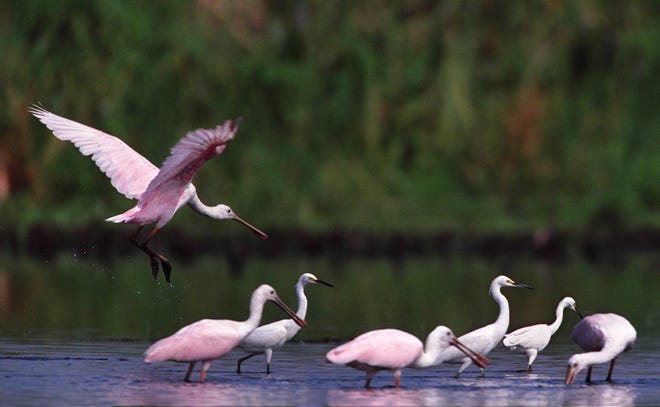A decision on how the most vital freshwater resource in the state will be managed for at least the next decade is imminent
with Palm Beach County officials mustering a fight to protect its water supply and environmental gems such as the Lake Worth Lagoon.
In an off-the-books meeting Thursday with U.S. Rep. Lois Frankel, D – West Palm Beach, about 40 municipal and county representatives discussed concerns about how Lake Okeechobee will be handled under a new plan called the Lake Okeechobee System Operating Manual, or LOSOM.
As early as today, the U.S. Army Corps of Engineers could release modeling for five options to choose from that will include details on preferred lake levels and when water is released to the northern estuaries and south to the Everglades.
Erica Skolte, a public affairs specialist for the Corps, said a tentative timeline includes choosing one of the options – or an alternative that could combine parts of multiple options – on July 16. A final decision would be announced Aug. 4.
Thursday’s virtual meeting, which was not open to the public, was hosted by City of West Palm Beach Mayor Keith James. City spokeswoman Kathleen Walter said the main intent of the meeting was to ask for support in getting more time to respond to the options developed by the Corps after the models are released.
In very simplified terms, the manual would, for example, tell the Corps to release water from the lake to the St. Lucie and Caloosahatchee estuaries when Lake Okeechobee gets to a certain level and depending on whether it’s the dry or wet season. The Corps has been following a schedule approved in 2008 after it was recognized that the Herbert Hoover Dike around Lake Okeechobee was in danger of failing at certain water levels.
More than a decade of repairs to the dike are expected to finish next year, triggering the Lake O management rewrite.
“Everybody is picking their horse before it’s even run a race and in a way that’s good because it means people are coming to understand the regulation schedule,” said Lake Worth Drainage District Executive Director Tommy Strowd, who participated in Thursday’s meeting. “We want to make sure we have enough time to dig into the performance summaries and understand what the models are doing.”
What’s at stake under the new management plan is the water supply to farms, homes and businesses that rely on Lake Okeechobee as either a primary or backup provider, recharge of groundwater coffers, and environmental concerns including funneling clean water south to the Everglades and away from the estuaries.
Lake Worth Lagoon Waterkeeper Reinaldo Diaz and Everglades Law Center Executive Director Lisa Interlandi pleaded their case to the Palm Beach Town Council on Tuesday, asking it to support a letter from environmental groups.
“We want the town to weigh in on our simple message to protect our estuaries and the Lake Worth Lagoon, and send water south to restore the Everglades,” Interlandi said. “This is non-controversial and the same message coming from the State of Florida.”
But many environmental groups are critical of farms in the Everglades Agricultural Area that have lobbied to keep Lake Okeechobee at higher levels to ensure they have water for their crops.
County Commissioner Melissa McKinlay, who represents the Glades area and was also on Thursday’s call, said it’s not just farmers who rely on the water.
“For us, the lake is [a] backup water supply. It’s backup for Broward and Miami Dade. For Okeechobee, it is their water supply,” said McKinlay, who expects letters from lake-bordering counties and lake-reliant cities will be penned in the next 48 hours asking for more time to review the project.

Greg Lovett/palmbeachpost.com
Tom MacVicar, a water resources consultant and former deputy director for the South Florida Water Management District, is representing lakeside communities in reviewing the proposed lake management option. He was listed as a speaker on an agenda for Thursday’s meeting.
For West Palm Beach, which also uses Lake Okeechobee water as a backup to buoy Grassy Waters Preserve, the discussion is timely. The city had to shut down its feed of lake water after toxic algae was found in the canal that brings water to the preserve – its main source of water. City officials believe that caused a chain reaction that eventually led to the cyanobacteria cylindrospermopsis to grow and release a toxin into the drinking water supply, which also serves Palm Beach and South Palm Beach.
Grassy Waters Preserve — a remnant of the Everglades — also sends water to the Northwest Fork of the Loxahatchee River, which is South Florida’s only federally designated wild and scenic river.
One thing all sides in Palm Beach County agree on is protecting the Lake Worth Lagoon from harmful discharges that flood in from the C-51 canal and can carry Lake Okeechobee water, as well as runoff from a 350,000-acre watershed.
Diaz said when water releases to the Lake Worth Lagoon are described in official documents, it’s often in terms of water moving from Lake Okeechobee through the L-8 canal “to tide” – a description he said dismisses the impacts on the lagoon.
The C-51 discharges to an area that is 8 miles from the Boynton Beach Inlet and 10 miles from the Lake Worth Inlet, which is also referred to as the Palm Beach Inlet. That distance limits flushing of the sediment and nutrient laden discharges.
An April 30 letter to the Corps from County Water Resources Manager Jeremy McBryan notes that $88 million in county and state money has been spent to restore the lagoon only to have Lake Okeechobee releases “wreak havoc” on the investments.
“We don’t have the headline-grabbing events that we see in other estuaries,” said Palm Beach County Director of Environmental Resources Deborah Drum during a February presentation on the lagoon. “We are lucky for that, but it makes us suffer a more insidious demise of death by a thousand papercuts. It’s more quietly degrading.”
The South Florida Water Management District has a workshop on the new Lake Okeechobee management plan scheduled for 10 a.m. June 29. For more information, go to www.sfwmd.gov/calendar/month.
Kmiller@pbpost.com
@Kmillerweather
